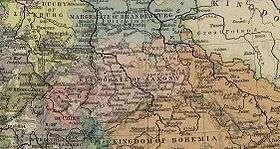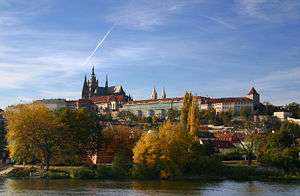Peace of Prague (1635)
| Pražský mír (cs) Prager Frieden (de) | |
|---|---|
|
Prague Castle | |
| Signed | 30 May 1635 |
| Location | Prague Castle, Bohemia |
| Signatories |
|
| Parties |
Catholic League Heilbronn League |
The Peace of Prague was a peace treaty signed on 30 May 1635 by the Habsburg Emperor Ferdinand II and Elector John George I of Saxony representing most of the Protestant Estates of the Holy Roman Empire. It effectively brought to an end the civil war aspect of the Thirty Years' War; however, the combat actions still carried on due to the continued intervention on German soil by Spain, Sweden, and, from mid-1635, France, until the Peace of Westphalia was concluded in 1648.
Prelude
Negotiations towards the agreement between the Emperor and the Saxon elector had been instigated by Landgrave George II of Hesse-Darmstadt, who whilst being a Lutheran prince had remained neutral during the Swedish intervention in 1630. Likewise, Elector John George I had initially supported Ferdinand II against the revolting Bohemian estates and maintained a neutral position throughout the following years. However, after continued plundering of the Saxon lands by the troops of the Catholic League, he had joined the Swedish forces of King Gustav Adolph at the 1631 Battle of Breitenfeld. The king's death at the Battle of Lützen in 1632 and the Protestant defeat at the 1634 Battle of Nördlingen prompted the elector to again switch sides.

The Emperor had seen achieved successes ruined by the Swedish invasion and found himself constrained to transfer extraordinary powers to his Generalissimo Albrecht von Wallenstein. After years of fighting, an inability to reimpose the Catholic confession by force, Wallenstein's assassination, and the need to put an end to the intervention of foreign powers in German affairs all combined to bring Ferdinand II to the table with a degree of willingness to make concessions towards the Lutheran estates.
Terms
After lengthy negotiations, the main terms of the treaty were:
- The Edict of Restitution of 1629 was effectively revoked, with the terms of the Peace of Augsburg of 1555 being re-established as at 12 November 1627. However, according to the Reservatum ecclesiasticum Protestant administrators of Prince-Bishoprics and Imperial abbeys still gained neither seat nor vote in the Imperial Diet. Ferdinand II continued to push the Counter-Reformation in the lands of the Habsburg Monarchy.
- Formal alliances of States of the Empire among themselves or with foreign powers were prohibited. This applied to both the Catholic League and the Protestant Heilbronn League, which thereupon dissolved.
- The armies of the various states were to be unified under the command of the Princes as generals of the Emperor, to establish an Army of the Holy Roman Empire as a whole, which would fight against invading troops.
- Amnesty was granted to those princes who had fought against Imperial troops, with the exception of the exiled descendants of the former "Winter King", Elector Palatine Frederick V (1596–1632).
Territorial changes

According to the Traditionsrezess annex executed in 1636, the Saxon electorate was granted the Bohemian crown lands of Lower and Upper Lusatia by Ferdinand II in his capacity as King of Bohemia. Both lands had already been given in pawn to Saxony in 1623, to pay for the support during the Bohemian revolt. The Saxon elector should only hold the Lusatias as hereditary fiefs and not secularize subsisting Catholic abbeys like Neuzelle or Marienthal.
Ferdinand was also forced to make individual concessions to some of the major states to get them to sign the treaty: The Margraviate of Brandenburg, since 1618 part of the personal union of Brandenburg-Prussia, had its claim to the Farther Pomeranian possessions of the last Duke Bogislaw XIV confirmed. Even the Catholic Electorate of Bavaria, which had supported the Emperor throughout the war, extracted some minor concessions.
Impact
Though militarily successful, Ferdinand II realized that his attempts to restore the Imperial authority had ultimatively failed and that he had to make concessions. As well as bringing to an end the fighting between the various states, the treaty should also bring to an end religion as a source of national conflict; the principle of cuius regio, eius religio was established for good within the Empire, confirmed by the 1648 Peace of Westphalia. In return the powers of the Emperor were strengthened by the prohibition on the Estates entering into strategic alliances.
The treaty was ratified by most Protestant Estates, however, an end to hostilities was not achieved. The Emperor sought to gain the support of the Princes both in the struggle against the Swedish intervention, and against the expected intervention of France. Meanwhile, the Hessian War continued between Landgrave George II of Hesse-Darmstadt and his Calvinist cousin William V of Hesse-Kassel, the Swedish forces still occupied Pomerania, and Prince Bernard of Saxe-Weimar with his army entered in French service. In 1648, Emperor Ferdinand III had to acquiesce in a much larger enfeeblement to reach a final peace.
